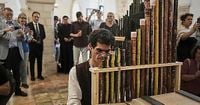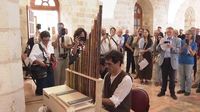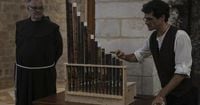After eight centuries of silence, a remarkable chapter in musical history has been reopened in Jerusalem’s Old City. On Tuesday, September 9, 2025, the oldest known pipe organ in the Christian world—comprising original pipes from the 11th century—rang out once more inside Saint Saviour’s Monastery. The occasion marked the end of an 800-year pause for an instrument whose very survival defies the odds, and whose restoration has captured the imagination of musicologists, historians, and the faithful alike.
The first notes to break the silence came from musician David Catalunya, who performed a liturgical chant called Benedicamus Domino Flos Filius. The organ’s hearty, resonant sound mingled with the distant toll of church bells, creating a moment that felt both ancient and startlingly present. According to the Associated Press, the unveiling drew a crowd of scholars and journalists—many of whom seemed awestruck by the instrument’s revival. Before the performance, Catalunya addressed the assembled audience, declaring, “This organ was buried with the hope that one day it would play again. And the day has arrived, nearly eight centuries later.”
The organ’s journey through time is as dramatic as its music. Researchers believe that Crusaders brought the organ to Bethlehem, the birthplace of Jesus, in the 11th century when they controlled Jerusalem. For about a century, its music accompanied worship in the city’s churches. But as the Crusader era waned and Muslim armies advanced, the organ’s custodians made a fateful decision: to bury the instrument, hoping to preserve it for a future they could scarcely imagine.
For centuries, the organ lay hidden in an ancient cemetery in Bethlehem. It wasn’t until 1906, during the construction of a new Franciscan hospice for pilgrims, that workers stumbled upon the long-buried treasure. Archaeologists soon uncovered 222 bronze pipes, a set of bells, and other artifacts, all carefully concealed by the Crusaders. The find was extraordinary, but the organ would not be heard again for another hundred years.
Fast forward to 2019, when a team of four researchers led by Catalunya embarked on a project to reconstruct the ancient instrument. Initially, their goal was to create a replica. But as they painstakingly examined the surviving pipes, they made a thrilling discovery: some of the original pipes were still functional, their voices preserved by centuries underground. Organ builder Winold van der Putten took on the delicate task of integrating these ancient pipes—marked with guiding lines from the original Ottoman craftsmen and engraved with musical notes—alongside replicas he crafted using traditional methods illuminated by close study of the originals.
“It was extremely moving to hear how some of these pipes came to life again after about 700 years under the earth and 800 years of silence,” said Koos van de Linde, an organ expert who participated in the restoration, in comments reported by AP. He added, "The hope of the Crusaders who buried them—that the moment would come when they would sound again—was not in vain.”
The revived organ now consists of about half original pipes, bearing the marks and scrawls of craftsmen from a millennium ago, and half meticulously crafted replicas. The instrument will be housed at the Terra Sancta museum in Jerusalem’s Old City, just a short distance from the Bethlehem church where it originally sounded. There, it will serve not only as a piece of living history but as a source of inspiration for musicians and researchers around the world.
Alvaro Torrente, director of the Instituto Complutense De Ciencias Musicales in Madrid—where Catalunya undertook much of his research—offered a striking comparison for the organ’s rediscovery. “It’s like finding a living dinosaur, something that we never imagined we could encounter, suddenly made real before our eyes and ears,” he said, as quoted by AP.
For Catalunya and his team, the project has yielded more than just music. The original pipes offer a rare window into the manufacturing processes of a thousand years ago. “This is an amazing set of information that allows us to reconstruct the manufacturing process so that we can build pipes exactly as they were made,” Catalunya explained at the news conference. The team now hopes to complete the restoration of the entire organ and to create copies that can be installed in churches across Europe and beyond, making the instrument’s unique sound accessible to a global audience.
The organ’s revival has been described as a grand development in the history of music. It’s easy to see why. The instrument bridges centuries of religious, cultural, and technological change, offering a tangible connection to the world of the Crusaders and the communities that once gathered around its music. The blend of original and replica pipes means that, when it plays, listeners are hearing both the literal voice of the past and the careful work of present-day artisans.
The story of the organ is also a testament to the power of hope and preservation. The Crusaders who buried the instrument could hardly have imagined the world in which it would one day be heard again. Their act of concealment was an act of faith—one that has been rewarded, centuries later, by the dedication of modern researchers and craftsmen.
The team’s work is not finished. Researchers are eager to complete the restoration and to share the organ’s sound with as many people as possible. Plans are underway to build copies for churches worldwide, ensuring that the music that once filled the air of 11th-century Bethlehem can again inspire worshippers and music lovers far beyond Jerusalem.
For those who witnessed the organ’s rebirth inside Saint Saviour’s Monastery, the experience was unforgettable. The ancient sound, echoing through the stone halls, was more than a musical performance—it was a dialogue across time, a reminder of the endurance of art and faith. As the last notes faded, there was a sense that something lost had been found, and that history, for a moment, had come alive.



